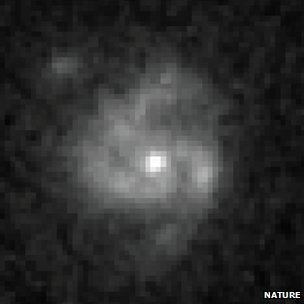First spiral galaxy in early Universe stuns astronomers
- Published

Astronomers have spotted the earliest known spiral galaxy, dating to just three billion years after the Big Bang.
Theories of galaxy formation held that the Universe was still too chaotic a place to allow such a perfectly formed or "grand-design" spiral to form.
It should take far longer for gravity to bring matter into thin, neat discs.
But a team reporting in Nature says the galaxy BX442 got the gravitational "kick" it needed to form a spiral from a smaller "dwarf galaxy" orbiting it.
They first spotted BX442 as the one and only spiral-looking object in a survey of 300 galaxies carried out by the Hubble space telescope, when they were shocked to see what looked to be a spiral galaxy.
"What we've learned when we look at galaxies at that epoch is that they're very dynamically hot," explained lead author of the study David Law from the University of Toronto's Dunlap Institute for Astronomy and Astrophysics.
"Even though we see some discs existing at that time, they're very thick and puffy, whereas the Milky Way has an... amount of random motion only about a tenth or so the amount of ordered rotation, giving rise to a very thin disc," he told BBC News.
To get a closer look at BX442, the team went on to use the OH-Suppressing Infrared Integral Field Spectrograph at the Keck observatory in Hawaii - which can subtract the effect of all the water that lies between the Earth and galaxies at such astronomical distances.
Those observations confirmed a hint apparent in the Hubble data: that BX442 was being orbited by a smaller "dwarf galaxy" at its edges.
"You can get a little extra help if you've got a satellite galaxy orbiting around," explained Dr Law.
"It gives that extra little gravitational kick to help accentuate the strength of the arm and make it into one of those eye-popping examples like the Whirlpool galaxy that you see all the pictures of."
Having proved that such grand-design spiral galaxies can exist at such an early age of the Universe, Dr Law said the team would now like to look into larger, wider-ranging galaxy surveys such as the Hubble telescope's ongoing Candels survey .
- Published3 February 2012
- Published11 January 2008
- Published1 July 2009